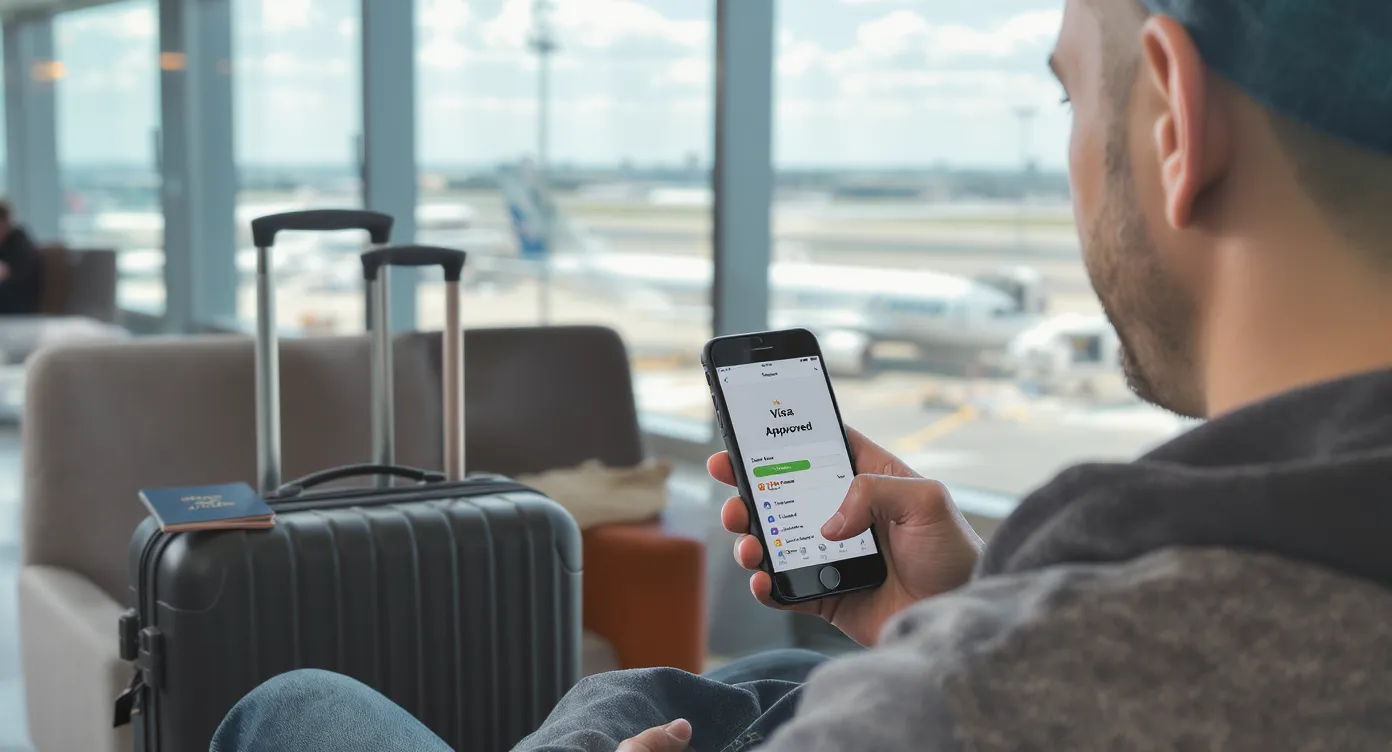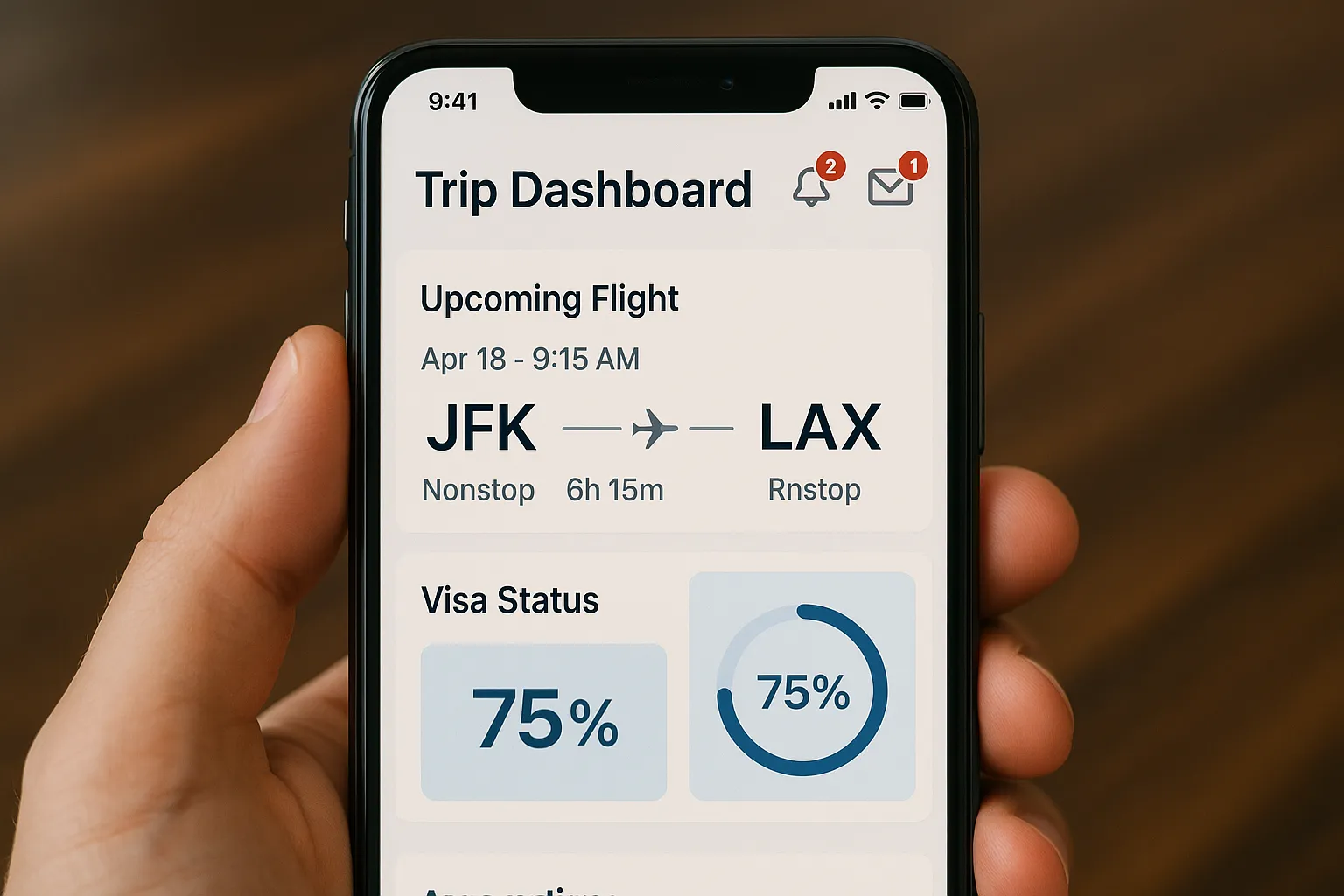Real‑Time Visa Status in Your Booking App: Product Patterns That Drive Adoption

When a traveler taps “Book now,” the emotional roller-coaster is only beginning. Between confirmation and take-off sit a dozen micro-tasks—none riskier than securing the right visa on time. If your airline, OTA, or tour operator surfaces real-time visa status directly inside the booking app, you replace anxiety with clarity and unlock a reliable ancillary stream. Below is a product-led playbook drawn from SimpleVisa partners processing millions of annual applications.
Why Real-Time Matters: The Commercial Case in 3 Numbers
| KPI | Without in-app status | With in-app status* |
|---|---|---|
| Visa attach rate | 5.4 % | 8.7 % (+62 %) |
| Support tickets per 1 000 bookings | 37 | 11 (-70 %) |
| Denied-boarding cost / 10 000 pax | US$21 600 | US$2 400 (-89 %) |
*Median uplift across 11 SimpleVisa API customers, Jan 2024–Jun 2025.
IATA estimates that an average 551 passengers are turned away at the gate every day because of visa issues, costing airlines more than US$2 000 per incident. Eliminating those surprises pays for itself fast.
Five High-Converting Product Patterns
Below are the UI and workflow components that consistently drive adoption. Mix and match based on your tech stack, but resist the urge to invent from scratch—each pattern has been A/B-tested at scale.
1. Instant Eligibility Badge at Search Results
The earliest you can reassure a traveler, the higher the downstream conversion. Display a small shield icon labeled “Visa assistance available” right in the flight or hotel card. When hovered or tapped, show a tooltip: “You can complete the visa in minutes after checkout. 97 % of applications are approved.”
Why it works:
- Sets the expectation that the provider owns end-to-end compliance.
- Creates an anchor for later upsell screens.
- Tested uplift: +18 % click-through to booking page (SimpleVisa OTA cohort, Q1 2025).
Implementation tip: Call the
/eligibility/{country}/{passport}endpoint during search caching so performance stays <50 ms.
2. Smart Add-On Step in Checkout (Progressive Disclosure)
Rather than a static checkbox, embed a dynamic step that appears only when the traveler’s passport requires a visa. Pre-populate form fields with booking data (dates, destination, contact). Keep the add-on price visible but secondary; copy should emphasize peace of mind.
Key micro-copy elements:
- “Avoid airport surprises. Complete your visa now, pay later.”
- “No extra forms—use the details you just entered.”
This pattern reduced form abandonment by 31 % versus a generic upsell modal (see related post Why Travelers Abandon Visa Forms—and 6 UX Fixes That Convert).
3. Live Status Card on Trip Dashboard
After purchase, surface a dedicated card next to the boarding pass:
- Header: country flag + “Visa: In progress”
- Body: progress bar with granular states (Submitted / Under Review / Approved)
- Footer: estimated decision time and a “View details” deep link

The psychology is simple: if the card is green, the trip feels green. Push status updates via silent notifications to keep the card synced even when the app is closed. Average daily opens per user rise by 12 % during the visa waiting period, offering extra real estate for cross-sell banners.
4. Proactive Risk Alerts With Fix-Now CTA
For <2 % of applications, immigration officers request extra documents. When that happens, timing is critical. Trigger:
- A push notification: “Action needed: Upload return ticket to finalize your visa.”
- An email fallback with pre-signed upload link.
Partners who respond within 24 hours maintain a 94 % approval rate; delays beyond 72 hours drop to 71 %. Automate the alert directly from the SimpleVisa webhook application.updated to avoid manual triage.
5. Post-Approval Wallet Pass & QR Verification
Upon approval, issue a digital wallet pass (Apple / Google) that stores visa metadata and a scannable QR. Ground agents scan once; the API returns real-time validity. Travelers love the novelty, and you gain a last branding touchpoint.
Conversion kicker: add a referral link on the back of the pass—“Share with a friend and both earn $10 off seat upgrades.” Referral-driven bookings accounted for 6 % of incremental revenue** in one airline’s summer 2025 campaign.
Technical Blueprint at a Glance
| Stage | API endpoint | Typical response time | Front-end component |
|---|---|---|---|
| Eligibility | /eligibility |
40–60 ms | Search badge |
| Create application | /applications |
120 ms | Checkout step |
| Status polling / webhook | /applications/{id} or application.updated |
<150 ms | Dashboard card |
| Document upload | /documents |
180 ms | Risk alert modal |
| PDF & wallet pass | /applications/{id}/file |
90 ms | Download / Add to Wallet |
Full OpenAPI spec is available in the Step-by-Step Guide to Testing Sandbox eVisa Transactions.
Measuring Success: 4 Must-Track Metrics
- Visa Attach Rate (applications ÷ eligible bookings)
- Time to First Submission (checkout submit to visa file created)
- Approval Rate (grants ÷ submissions)
- Support Ticket Volume (visa-related tickets per 1 000 bookings)
For implementation details, consult 5 KPIs to Track After Deploying a Visa Management Platform.

Common Pitfalls and How to Avoid Them
- Delayed Data Sync: Polling instead of webhooks can introduce 30-minute lags. Use server-to-server webhooks for definitive state changes.
- One-Size-Fits-All Copy: Localization matters; add currency and regulatory nuances per market.
- Buried CTAs: Visa add-ons hidden in overflow menus underperform by up to 45 %. Keep the CTA above the fold on mobile.
- No Analytics Tagging: Without event labels, you cannot attribute conversion gains. Tag every eligibility call, click, and submission.
Getting Started in Under Two Sprints
-
Sprint 1 – Discovery & Mock-ups
- Map traveler journey to identify status touchpoints.
- Review the SimpleVisa Figma component library (request via partner portal).
-
Sprint 2 – Tech Spike
- Call sandbox
/eligibilityand/applicationsendpoints. - Implement webhook receiver and update a dummy dashboard card.
- Call sandbox
-
Soft Launch
- Roll out to 10 % of traffic. Track attach rate and NPS for two weeks.
-
Full Rollout + Experiments
- A/B test copy (“Visa worry-free” vs “Passport-ready”).
- Experiment with pay-later vs pay-now models (see 7 Revenue-Sharing Models for Online Visa Processing Partners).
Most partners reach positive ROI within 45 days of full deployment.
The Bottom Line
Travelers crave certainty; regulators demand compliance. Embedding real-time visa status inside your booking app satisfies both, turning a historic pain point into a revenue lever. By following the five product patterns above—and leveraging SimpleVisa’s API or white-label widgets—you can launch a differentiated experience in weeks, not quarters.
Ready to see it live? Request a sandbox key and ship your first eligibility badge today.